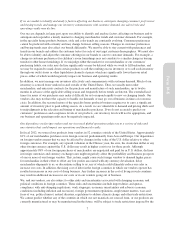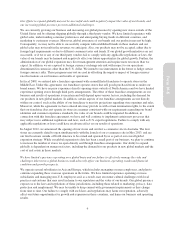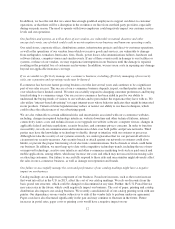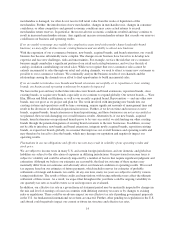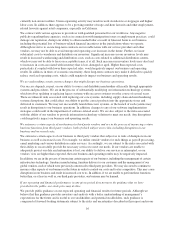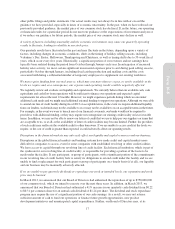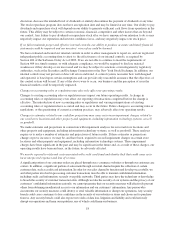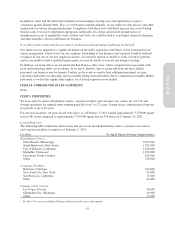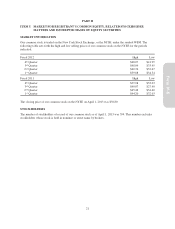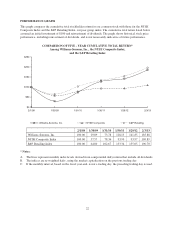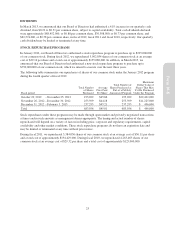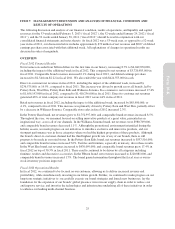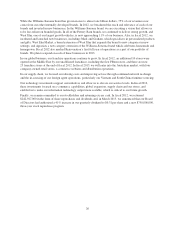Pottery Barn 2012 Annual Report Download - page 31
Download and view the complete annual report
Please find page 31 of the 2012 Pottery Barn annual report below. You can navigate through the pages in the report by either clicking on the pages listed below, or by using the keyword search tool below to find specific information within the annual report.
other public filings and public statements. Our actual results may not always be in line with or exceed the
guidance we have provided, especially in times of economic uncertainty. In the past, when we have reduced our
previously provided guidance, the market price of our common stock has declined. If, in the future, our operating
or financial results for a particular period do not meet our guidance or the expectations of investment analysts or
if we reduce our guidance for future periods, the market price of our common stock may decline as well.
A variety of factors, including seasonality and the economic environment, may cause our quarterly operating
results to fluctuate, leading to volatility in our stock price.
Our quarterly results have fluctuated in the past and may fluctuate in the future, depending upon a variety of
factors, including changes in economic conditions, shifts in the timing of holiday selling seasons, including
Valentine’s Day, Easter, Halloween, Thanksgiving and Christmas, as well as timing shifts due to 53-week fiscal
years, which occur every five years. Historically, a significant portion of our revenues and net earnings have
typically been realized during the period from October through January each year. In anticipation of increased
holiday sales activity, we incur certain significant incremental expenses prior to and during peak selling seasons,
particularly October through January, including fixed catalog production and mailing costs and the costs
associated with hiring a substantial number of temporary employees to supplement our existing workforce.
We may require funding from external sources, which may cost more than we expect, or not be available at the
levels we require and, as a consequence, our expenses and operating results could be negatively affected.
We regularly review and evaluate our liquidity and capital needs. We currently believe that our available cash, cash
equivalents and cash flow from operations will be sufficient to finance our operations and expected capital
requirements for at least the next 12 months. However, we might experience periods during which we encounter
additional cash needs and we might need additional external funding to support our operations. Although we were able
to amend our line of credit facility during fiscal 2012 on acceptable terms, in the event we require additional liquidity
from our lenders, such funds may not be available to us or may not be available to us on acceptable terms in the future.
For example, in the event we were to breach any of our financial covenants, our banks would not be required to
provide us with additional funding, or they may require us to renegotiate our existing credit facility on less favorable
terms. In addition, we may not be able to renew our letters of credit that we use to help pay our suppliers on terms that
are acceptable to us, or at all, as the availability of letter of credit facilities may become limited. Further, the providers
of such credit may reallocate the available credit to other borrowers. If we are unable to access credit at the levels we
require, or the cost of credit is greater than expected, it could adversely affect our operating results.
Disruptions in the financial markets may adversely affect our liquidity and capital resources and our business.
Disruptions in the global financial markets and banking systems have made credit and capital markets more
difficult for companies to access, even for some companies with established revolving or other credit facilities.
We have access to capital through our revolving line of credit facility. Each financial institution, which is part of
the syndicate for our revolving line of credit facility, is responsible for providing a portion of the loans to be
made under the facility. If any participant, or group of participants, with a significant portion of the commitments
in our revolving line of credit facility fails to satisfy its obligations to extend credit under the facility and we are
unable to find a replacement for such participant or group of participants on a timely basis (if at all), our liquidity
and our business may be materially adversely affected.
If we are unable to pay quarterly dividends or repurchase our stock at intended levels, our reputation and stock
price may be harmed.
In March 2013, we announced that our Board of Directors had authorized the repurchase of up to $750,000,000
of our common stock, which we intend to execute over the next three years. In addition, in March 2013, we
announced that our Board of Directors had authorized a 41% increase in our quarterly cash dividend from $0.22
to $0.31 per common share for an annual cash dividend of $1.24 per share. The dividend and stock repurchase
program may require the use of a significant portion of our cash earnings. As a result, we may not retain a
sufficient amount of cash to fund our operations or finance future growth opportunities, new product
development initiatives and unanticipated capital expenditures. Further, our Board of Directors may, at its
17
Form 10-K


